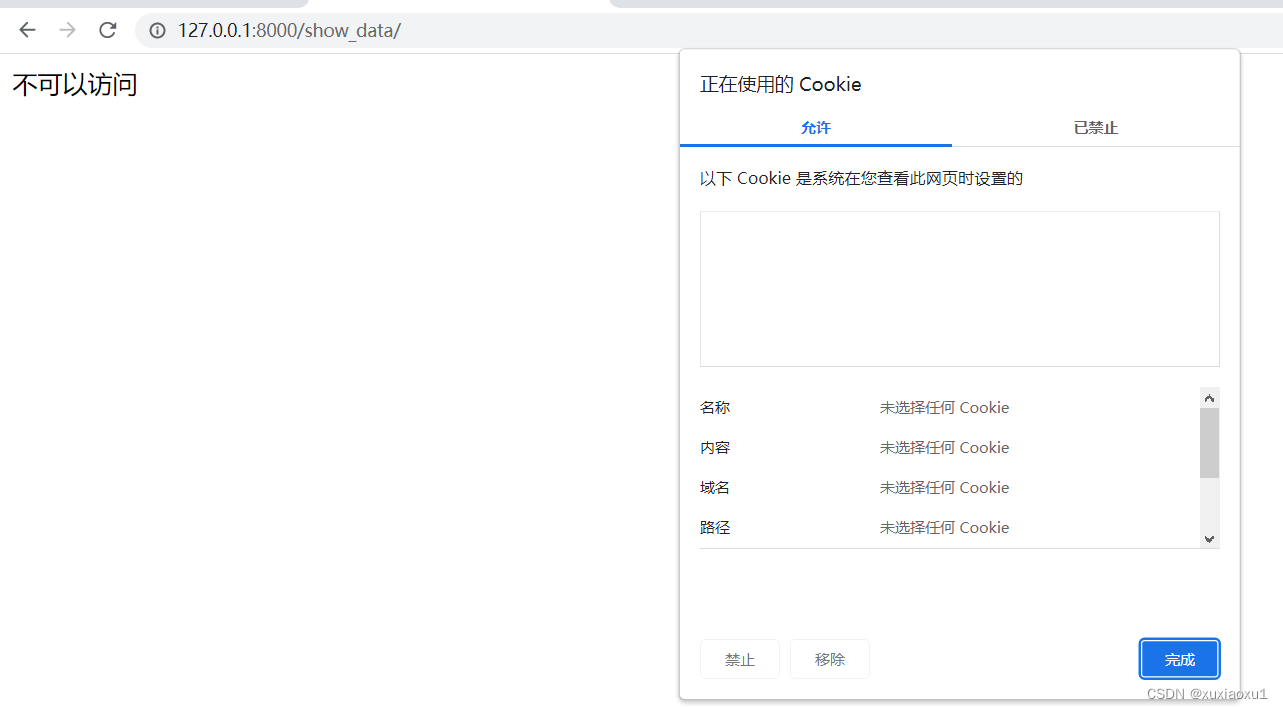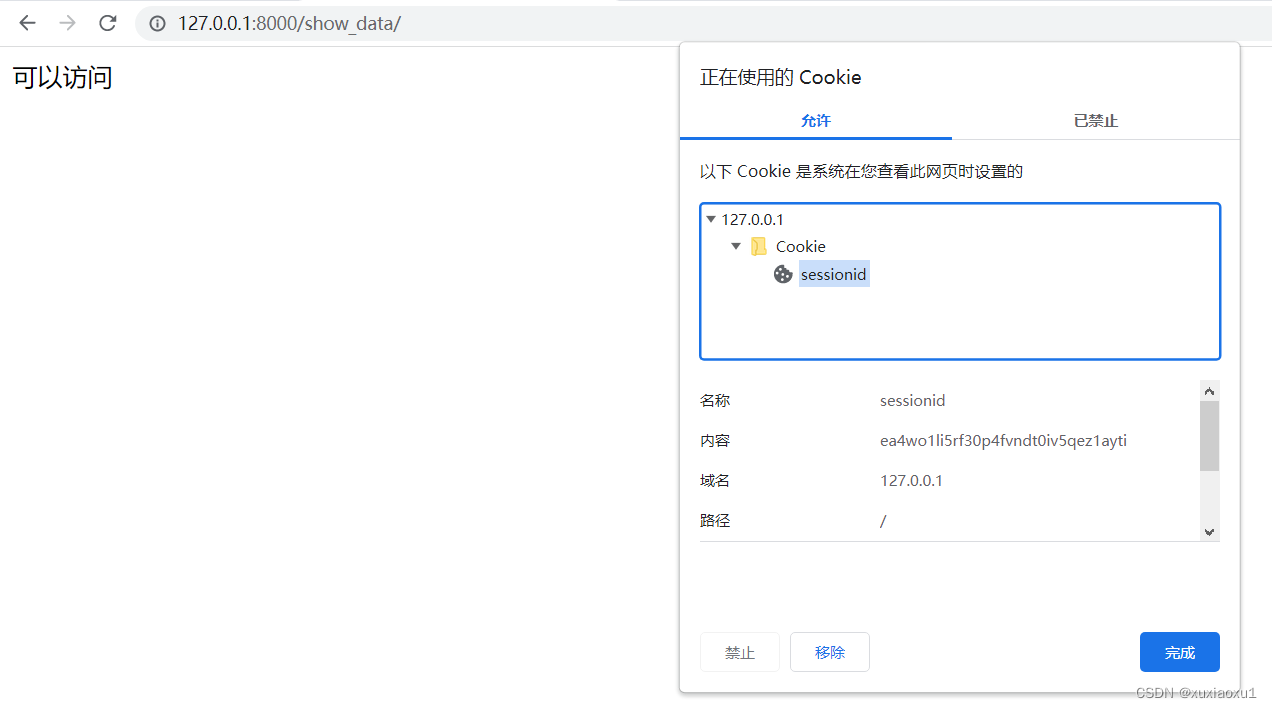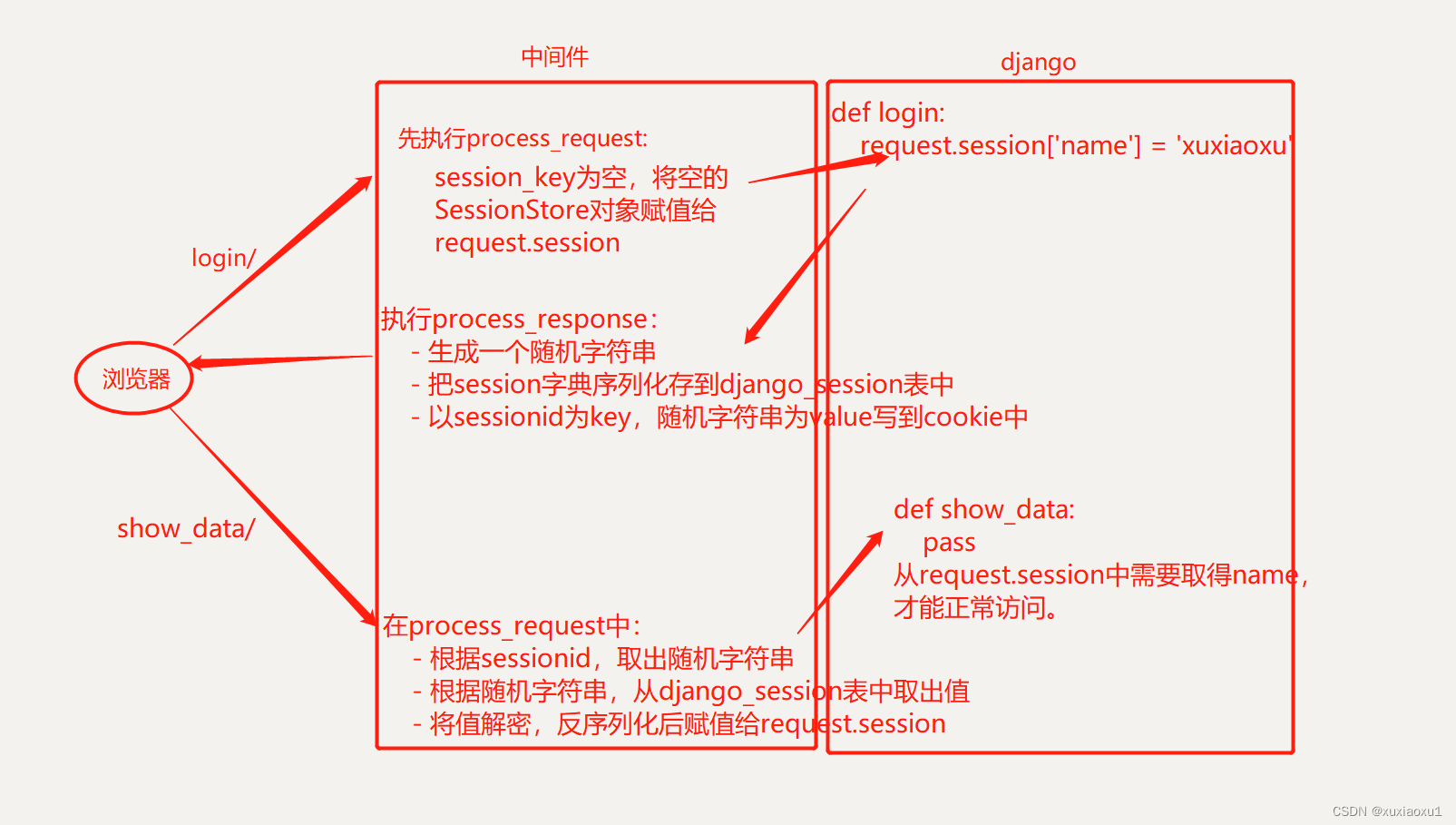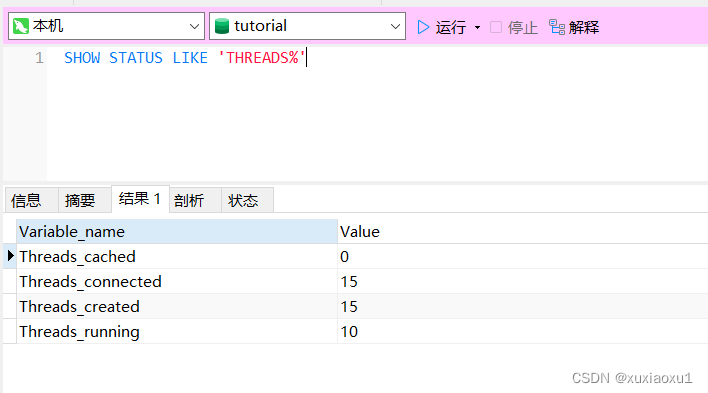Flask
一 前言
Flask是一个基于Python开发并且依赖jinja2模板(模板语言)和Werkzeug WSGI服务的一个微型框架,对于Werkzeug本质是Socket服务端,其用于接收http请求并对请求进行预处理,然后触发Flask框架,开发人员基于Flask框架提供的功能对请求进行相应的处理,并返回给用户,如果要返回给用户复杂的内容时,需要借助jinja2模板来实现对模板的处理,即:将模板和数据进行渲染,将渲染后的字符串返回给用户浏览器。
“微”(micro) 并不表示你需要把整个 Web 应用塞进单个 Python 文件(虽然确实可以 ),也不意味着 Flask 在功能上有所欠缺。微框架中的“微”意味着 Flask 旨在保持核心简单而易于扩展。Flask 不会替你做出太多决策——比如使用何种数据库。而那些 Flask 所选择的——比如使用何种模板引擎——则很容易替换。除此之外的一切都由可由你掌握。如此,Flask 可以与您珠联璧合。
默认情况下,Flask 不包含数据库抽象层、表单验证,或是其它任何已有多种库可以胜任的功能。然而,Flask 支持用扩展来给应用添加这些功能,如同是 Flask 本身实现的一样。众多的扩展提供了数据库集成、表单验证、上传处理、各种各样的开放认证技术等功能。Flask 也许是“微小”的,但它已准备好在需求繁杂的生产环境中投入使用。
Flask官方文档:
https://dormousehole.readthedocs.io/en/latest/
二 快速使用
安装
pip install Flask
使用
from flask import Flask # 导入Flask类# 实例化产生Flask对象 有了__name__ Flask才知道在哪里找到模板和静态文件
app = Flask(__name__)# 使用route装饰器来声明路由匹配成功执行的视图函数@app.route('/')defhello_word():return'Hello World!'if __name__ =='__main__':
app.run()
三 内置配置变量
在Flask类实例化app对象时将默认配置赋值给了
app.config
。
Flask/init
#: The configuration dictionary as :class:`Config`. This behaves#: exactly like a regular dictionary but supports additional methods#: to load a config from files.
self.config = self.make_config(instance_relative_config))
flask/app.py
default_config = ImmutableDict(
{
"ENV": None,
"DEBUG": None,
"TESTING": False,
"PROPAGATE_EXCEPTIONS": None,
"PRESERVE_CONTEXT_ON_EXCEPTION": None,
"SECRET_KEY": None,
"PERMANENT_SESSION_LIFETIME": timedelta(days=31),
"USE_X_SENDFILE": False,
"SERVER_NAME": None,
"APPLICATION_ROOT": "/",
"SESSION_COOKIE_NAME": "session",
"SESSION_COOKIE_DOMAIN": None,
"SESSION_COOKIE_PATH": None,
"SESSION_COOKIE_HTTPONLY": True,
"SESSION_COOKIE_SECURE": False,
"SESSION_COOKIE_SAMESITE": None,
"SESSION_REFRESH_EACH_REQUEST": True,
"MAX_CONTENT_LENGTH": None,
"SEND_FILE_MAX_AGE_DEFAULT": None,
"TRAP_BAD_REQUEST_ERRORS": None,
"TRAP_HTTP_EXCEPTIONS": False,
"EXPLAIN_TEMPLATE_LOADING": False,
"PREFERRED_URL_SCHEME": "http",
"JSON_AS_ASCII": True,
"JSON_SORT_KEYS": True,
"JSONIFY_PRETTYPRINT_REGULAR": False,
"JSONIFY_MIMETYPE": "application/json",
"TEMPLATES_AUTO_RELOAD": None,
"MAX_COOKIE_SIZE": 4093,
}
ENV
:应用运行于什么环境。 Flask 和 扩展可以根据环境不同而行为不同,如打开或 关闭调试模式。 env 属性映射了这个配置键。本变量由 FLASK_ENV 环境变量设置。如果本变量是在代码中设置的话,可能出 现意外。在生产环境中不要使用 development 。
DEBUG
:是否开启调试模式。使用 flask run 启动开发服务器时,遇到未能处理的 异常时会显示一个交互调试器,并且当代码变动后服务器会重启。 debug 属性映射了这个配置键。当 ENV 是 ‘development’ 时,本变量会启用,并且会被 FLASK_DEBUG 环境变量 重载。如果本变量是在代码中设置的话,可能会出现意外。在生产环境中不要开启调试模式。
TESTING
:开启测试模式。异常会被广播而不是被应用的错误处理器处理。扩展可能也会为 了测试方便而改变它们的行为。你应当在自己的调试中开启本变量。
PROPAGATE_EXCEPTIONS
:异常会重新引发而不是被应用的错误处理器处理。在没有设置本变量的情况下, 当 TESTING 或 DEBUG 开启时,本变量隐式地为真。
PRESERVE_CONTEXT_ON_EXCEPTION
:当异常发生时,不要弹出请求情境。在没有设置该变量的情况下,如果 DEBUG 为真,则本变量为真。这样允许调试器错误请求数据。本变量通常不 需要直接设置。
SECRET_KEY
:密钥用于会话 cookie 的安全签名,并可用于应用或者扩展的其他安全需求。 密钥应当是一个长的随机的 bytes 或者 str 。例如,复制下面的 输出到你的配置中:
import secrets
print(secrets.token_hex())# cd607def747f7d3f0d15219cf3e89b6e5be13aafe91d163a676ed6d54bb09ecd
PERMANENT_SESSION_LIFETIME
:如果 session.permanent 为真, cookie 的有效期为本变量设置的数字, 单位为秒。本变量可能是一个 datetime.timedelta 或者一个 int 。
USE_X_SENDFILE
:当使用 Flask 提供文件服务时,设置 X-Sendfile 头部。有些网络服务器, 如 Apache ,识别这种头部,以利于更有效地提供数据服务。本变量只有使用这 种服务器时才有效。
SERVER_NAME
:通知应用其所绑定的主机和端口。子域路由匹配需要本变量。
APPLICATION_ROOT
:通知应用应用的根路径是什么。这个变量用于生成请求环境之外的 URL。
SESSION_COOKIE_NAME
:会话 cookie 的名称。假如已存在同名 cookie ,本变量可改变。
SESSION_COOKIE_DOMAIN
:认可会话 cookie 的域的匹配规则。如果本变量没有设置,那么 cookie 会被 SERVER_NAME 的所有子域认可。如果本变量设置为 False ,那么 cookie 域不会被设置。
SESSION_COOKIE_PATH
:认可会话 cookie 的路径。如果没有设置本变量,那么路径为 APPLICATION_ROOT ,如果 APPLICATION_ROOT 也没有设置,那么会是 / 。
SESSION_COOKIE_HTTPONLY
:为了安全,浏览器不会允许 JavaScript 操作标记为“ HTTP only ”的 cookie 。
SESSION_COOKIE_SECURE
:如果 cookie 标记为“ secure ”,那么浏览器只会使用基于 HTTPS 的请求发 送 cookie 。应用必须使用 HTTPS 服务来启用本变量。
SESSION_COOKIE_SAMESITE
:限制来自外部站点的请求如何发送 cookie 。可以被设置为 ‘Lax’ (推荐) 或者 ‘Strict’ 。
SESSION_REFRESH_EACH_REQUEST
:当 session.permanent 为真时,控制是否每个响应都发送 cookie 。每次 都发送 cookie (缺省情况)可以有效地防止会话过期,但是会使用更多的带宽。 会持续会话不受影响。
MAX_CONTENT_LENGTH
:在进来的请求数据中读取的最大字节数。如果本变量没有配置,并且请求没有指 定 CONTENT_LENGTH ,那么为了安全原因,不会读任何数据。
SEND_FILE_MAX_AGE_DEFAULT
:当提供文件服务时,设置缓存控制最长存活期,以秒为单位。可以是一个 datetime.timedelta 或者一个 int 。在一个应用或者蓝图上 使用 get_send_file_max_age() 可以基于单个文件重载 本变量。
TRAP_BAD_REQUEST_ERRORS
:尝试操作一个请求字典中不存在的键,如 args 和 form ,会返回一个 400 Bad Request error 页面。开启本变量,可以把这种错误作为一个未处理的 异常处理,这样就可以使用交互调试器了。本变量是一个特殊版本的 TRAP_HTTP_EXCEPTIONS 。如果没有设置,本变量会在调试模式下开启。
TRAP_HTTP_EXCEPTIONS
:如果没有处理 HTTPException 类型异常的处理器,重新引发该异常用于被 交互调试器处理,而不是作为一个简单的错误响应来返回。
EXPLAIN_TEMPLATE_LOADING
:记录模板文件如何载入的调试信息。使用本变量有助于查找为什么模板没有载入 或者载入了错误的模板的原因。
PREFERRED_URL_SCHEME
:当不在请求情境内时使用些预案生成外部 URL 。
JSON_AS_ASCII
:把对象序列化为 ASCII-encoded JSON 。如果禁用,那么 jsonify 返回 的 JSON 会包含 Unicode 字符。这样的话,在把 JSON 渲染到 JavaScript 时会有安全隐患。因此,通常应当开启这个变量。
JSON_SORT_KEYS
:按字母排序 JSON 对象的键。这对于缓存是有用的,因为不管 Python 的哈希种 子是什么都能够保证数据以相同的方式序列化。为了以缓存为代价的性能提高可 以禁用它,虽然不推荐这样做。
JSONIFY_PRETTYPRINT_REGULAR
:jsonify 响应会输出新行、空格和缩进以便于阅读。在调试模式下总是启用 的。
JSONIFY_MIMETYPE
:jsonify 响应的媒体类型。
TEMPLATES_AUTO_RELOAD
:当模板改变时重载它们。如果没有配置,在调试模式下会启用。
MAX_COOKIE_SIZE
:当 cookie 头部大于本变量配置的字节数时发出警告。缺省值为 4093 。 更大的 cookie 会被浏览器悄悄地忽略。本变量设置为 0 时关闭警告。
四 配置文件的写法
1. 直接通过app对象添加配置
app = Flask(__name__)print(app.config)
app.debug =True
app.secret_key = secrets.token_hex()print(app.config)

2. 通过app.config配置
app = Flask(__name__)print(app.config)
app.config['DEBUG']=True
app.config['SECRET_KEY']= secrets.token_hex()print(app.config)
3. 通过配置文件
settings.py
import secrets
DEBUG =True
SECRET_KEY = secrets.token_hex()
app.py
app = Flask(__name__)
app.config.from_pyfile('settings.py')print(app.config)
4. 通过类配置
setting_class.py
# 开发配置classDevelopmentConfig:
DEBUG =True
SERVER_NAME ='localhost'# 上线配置classProductionConfig:
DEBUG =False
SERVER_NAME ='192.168.1.11'
app.py
app.config.from_object('setting_class.ProductionConfig')print(app.config)
5. 其他
app.config.from_envvar("环境变量名称")
app.config.from_json("json文件名称")
五 路由
现代 web 应用都使用有意义的 URL ,这样有助于用户记忆,网页会更得到用户的青睐, 提高回头率。
使用 route() 装饰器来把函数绑定到 URL:
@app.route('/')defindex():return'index page!'@app.route('/login')deflogin():return'login page!'
但是能做的不仅仅是这些!您可以动态变化 URL 的某些部分, 还可以为一个函数指定多个规则。
通过把 URL 的一部分标记为
<variable_name>
就可以在 URL 中添加变量。标记的 部分会作为关键字参数传递给函数。通过使用
<converter:variable_name>
,可以 选择性的加上一个转换器,为变量指定规则。请看下面的例子:
from flask import Flask
app = Flask(__name__)@app.route('/user/<username>')defshow_user_profile(username):# 显示该用户returnf'User {username}'@app.route('/post/<int:post_id>')defshow_post(post_id):# 显示id是一个数字returnf'Post {post_id}'@app.route('/path/<path:subpath>')defshow_subpath(subpath):# 显示path后的子路径returnf'Subpath {subpath}'if __name__ =='__main__':
app.run()



route参数
- methods:列表,规定请求的方式,如果列表中没有,该请求方式不被支持。
- endpoint:路由别名,如果不写,会以被装饰的函数名作为别名。
转换器类型:
类型描述string接受任何不包含斜杠的字符串int接受任意正整数float接受正浮点数path类似于string,但可以包含斜杠uuid接受UUID字符串
路由源码
@app.route('/')defhello_word():return'Hello World!'
首先执行app对象(Flask的对象)的
route()
方法。
# rule是路由defroute(self, rule,**options):# 定义decorator函数defdecorator(f):
endpoint = options.pop("endpoint",None)
self.add_url_rule(rule, endpoint, f,**options)return f
# 返回decorator函数return decorator
route()
函数执行完后,视图函数就相当于下面:
@decoratordefhello_word():return'Hello World!'
接着执行
decorator(hello_word)
# f是视图函数(hello_word)defdecorator(f):# 取出别名,不传就为None
endpoint = options.pop("endpoint",None)# self是app对象# 接着调用app对象的add_url_rule方法
self.add_url_rule(rule, endpoint, f,**options)# 返回视图函数return f
接着调用app对象的add_url_rule方法。
defadd_url_rule(self, rule, endpoint=None, view_func=None, provide_automatic_options=None,**options):if endpoint isNone:# 如果endpoint没传,就执行_endpoint_from_view_func方法# _endpoint_from_view_func返回视图函数的视图名# 所以不传endpoint参数,会以视图函数名作为endpoint
endpoint = _endpoint_from_view_func(view_func)# type: ignore
options["endpoint"]= endpoint
methods = options.pop("methods",None)# 如果没有传methods参数if methods isNone:# 就从视图函数中反射methods属性,没有的话就为一个元组("GET",)
methods =getattr(view_func,"methods",None)or("GET",)# methods不能是字符串ifisinstance(methods,str):raise TypeError("Allowed methods must be a list of strings, for"' example: @app.route(..., methods=["POST"])')# 这是一个集合生成式,保证集合里的元素不重复
methods ={item.upper()for item in methods}# 添加必要的方法 也是一个集合
required_methods =set(getattr(view_func,"required_methods",()))# starting with Flask 0.8 the view_func object can disable and# force-enable the automatic options handling.if provide_automatic_options isNone:
provide_automatic_options =getattr(
view_func,"provide_automatic_options",None)if provide_automatic_options isNone:if"OPTIONS"notin methods:
provide_automatic_options =True
required_methods.add("OPTIONS")else:
provide_automatic_options =False# Add the required methods now.# | 表示集合求并集
methods |= required_methods
# self.url_rule_class是Flask类实例化时设置的# url_rule_class = Rule# rule就是Rule实例化的对象
rule = self.url_rule_class(rule, methods=methods,**options)
rule.provide_automatic_options = provide_automatic_options # type: ignore# self.url_map也是在Falsk实例化时设置的# self.url_map = self.url_map_class()# url_map_class = Map
self.url_map.add(rule)if view_func isnotNone:# self.view_functions: t.Dict[str, t.Callable] = {} 是一个字典
old_func = self.view_functions.get(endpoint)if old_func isnotNoneand old_func != view_func:raise AssertionError("View function mapping is overwriting an existing"f" endpoint function: {endpoint}")# self.view_functions = {'别名':视图函数}
self.view_functions[endpoint]= view_func
_endpoint_from_view_func(view_func)
方法
def_endpoint_from_view_func(view_func: t.Callable)->str:"""Internal helper that returns the default endpoint for a given
function. This always is the function name.
"""# 断言视图函数不为空assert view_func isnotNone,"expected view func if endpoint is not provided."# 返回视图函数的函数名return view_func.__name__
总结:
路由注册其实就是调用了app对象的
add_url_rule()
方法,那么也可以不用装饰器的方式来注册路由。
app.add_url_rule('/user/<username>', view_func=show_user_profile)
app.route和app.add_url_rule参数:
rule:URL规则
view_func:视图函数名称
defaults = None:默认值, 当URL中无参数,函数需要参数时,使用defaults = {'k': 'v'}
endpoint = None:名称
methods = None:允许的请求方式,如:["GET", "POST"]
strict_slashes:对URL最后的 / 符号是否严格要求
@app.route('/index', strict_slashes=False)
#访问http://www.xx.com/index/ 或http://www.xx.com/index均可
@app.route('/index', strict_slashes=True)
#仅访问http://www.xx.com/index
redirect_to:重定向到指定地址
@app.route('/index/<int:nid>', redirect_to='/home/<nid>')
使用装饰器完成登录认证
from flask import Flask, render_template, request, redirect, session, url_for
app = Flask(__name__)
app.debug =True
app.secret_key ='sdfsdfsdfsdf'
USERS ={1:{'name':'张三','age':18,'gender':'男','text':"道路千万条"},2:{'name':'李四','age':28,'gender':'男','text':"安全第一条"},3:{'name':'王五','age':18,'gender':'女','text':"行车不规范"},}from functools import wraps
defauth(func):# 这里如果不使用wraps装饰器,func视图函数就变成了inner# endpoint就会重复,程序就会报错# 这里不加就要在route函数中指定endpoint参数@wraps(func)definner(*args,**kwargs):
user = session.get('user_info')if user:
res = func(*args,**kwargs)return res
return redirect('/login')return inner
@app.route('/detail/<int:nid>', methods=['GET'])@authdefdetail(nid):
info = USERS.get(nid)return render_template('detail.html', info=info)@app.route('/index', methods=['GET'])@authdefindex():return render_template('index.html', user_dict=USERS)@app.route('/login', methods=['GET','POST'])deflogin():if request.method =="GET":return render_template('login.html')else:# request.query_string
user = request.form.get('user')
pwd = request.form.get('pwd')if user =='xuxiaoxu'and pwd =='123':
session['user_info']= user
return redirect('/index')return render_template('login.html', error='用户名或密码错误')if __name__ =='__main__':
app.run()
六 cbv写法
6.1 快速使用
from flask import Flask
from flask.views import MethodView
app = Flask(__name__)classTest(MethodView):defget(self):return'get'defpost(self):return'post'
app.add_url_rule(rule='/test', view_func=Test.as_view(name='test'))if __name__ =='__main__':
app.run()
6.2 cbv加装饰器
View/as_view
# cls是视图类# 如果在视图类中配置了decorators属性if cls.decorators:# 将as_view传入的name参数赋值给view函数的名字
view.__name__ = name
view.__module__ = cls.__module__
# 循环拿出每一个装饰器函数for decorator in cls.decorators:# 相当于 # @decorator # def view():# pass
view = decorator(view)
6.3 as_view的执行流程
View/as_view
@classmethod# 是一个类方法 # cls是视图类,name必须传,不传会报错。defas_view(cls, name,*class_args,**class_kwargs):# 定义view函数defview(*args,**kwargs):
self = view.view_class(*class_args,**class_kwargs)# type: ignorereturn current_app.ensure_sync(self.dispatch_request)(*args,**kwargs)# 如果有装饰器,在这里执行装饰器if cls.decorators:
view.__name__ = name
view.__module__ = cls.__module__
for decorator in cls.decorators:
view = decorator(view)# 修改和增加view函数的属性
view.__name__ = name
view.__doc__ = cls.__doc__
view.__module__ = cls.__module__
view.methods = cls.methods # type: ignore
view.provide_automatic_options = cls.provide_automatic_options # type: ignore# 返回view函数return view
请求匹配成功,会执行
as_view中的view
defview(*args,**kwargs):# view.view_class是在执行as_view赋值给view函数的,是视图类# 所以self就是视图类的对象
self = view.view_class(*class_args,**class_kwargs)# type: ignore# 先执行self.dispatch_requestreturn current_app.ensure_sync(self.dispatch_request)(*args,**kwargs)
接着执行
self.dispatch_request
self是视图类的对象。
defdispatch_request(self,*args,**kwargs):# 从视图类对象中获取请求方式的视图函数内存地址
meth =getattr(self, request.method.lower(),None)# If the request method is HEAD and we don't have a handler for it# retry with GET.if meth isNoneand request.method =="HEAD":
meth =getattr(self,"get",None)assert meth isnotNone,f"Unimplemented method {request.method!r}"# 执行视图函数return current_app.ensure_sync(meth)(*args,**kwargs)
6.4 as_view的name参数
执行了as_view()函数,as_view的内层函数view的函数名就变成了name指定的值。
接着执行app.add_url_rule函数,如果没有指定endpoint参数,endpoint是view函数的函数名,就是as_view传的name参数。如果指定了endpoint参数,endpoint就是指定的endpoint参数值,和view的函数名就没有关系了。
6.5 继承View写cbv
from flask import Flask
from flask.views import View
app = Flask(__name__)classTest(View):defget(self):return'get'
app.add_url_rule('/test', view_func=Test.as_view(name='test'))if __name__ =='__main__':
app.run()
defdispatch_request(self)-> ResponseReturnValue:"""Subclasses have to override this method to implement the
actual view function code. This method is called with all
the arguments from the URL rule.
"""raise NotImplementedError()
在执行
self.dispatch_request
是或抛出
NotImplementedError
异常,继承View写cbv需要自己定制
dispatch_request
方法。
七 模板语法
7.1 渲染变量
<!DOCTYPEhtml><htmllang="en"><head><metacharset="UTF-8"><title>Title</title></head><body><h1>用户列表</h1><table>
{% for k,v in user_dict.items() %}
<tr><td>{{k}}</td><td>{{v.name}}</td><td>{{v['name']}}</td><td>{{v.get('name')}}</td><td><ahref="/detail/{{k}}">查看详细</a></td></tr>
{% endfor %}
</table></body></html>
7.2 变量的循环
<!DOCTYPEhtml><htmllang="en"><head><metacharset="UTF-8"><title>Title</title></head><body><h1>用户列表</h1><table>
{% for k,v in user_dict.items() %}
<tr><td>{{k}}</td><td>{{v.name}}</td><td>{{v['name']}}</td><td>{{v.get('name')}}</td><td><ahref="/detail/{{k}}">查看详细</a></td></tr>
{% endfor %}
</table></body></html>
7.3 逻辑判断
<!DOCTYPEhtml><htmllang="en"><head><metacharset="UTF-8"><title>Title</title></head><body><h1>用户列表</h1><table>
{% if name %}
<h1>Hello {{ name }}!</h1>
{% else %}
<h1>Hello World!</h1>
{% endif %}
</table></body></html>
比django中多可以加括号,执行函数,传参数
# Markup等价django的mark_safe from flask import Flask,render_template,Markup,jsonify,make_response
app = Flask(__name__)deffunc1(arg):return Markup("<input type='text' value='%s' />"%(arg,))@app.route('/')defindex():return render_template('index.html',ff = func1)if __name__ =='__main__':
app.run()
八 请求与响应
8.1 请求对象
官方文档:
https://dormousehole.readthedocs.io/en/latest/api.html#flask.Request
request.method # 提交的方法
request.args # get请求提及的数据
request.form # post请求提交的数据
request.values # post和get提交的数据总和
request.cookies # 客户端所带的cookie
request.headers # 请求头
request.path # 不带域名,请求路径
request.full_path # 不带域名,带参数的请求路径
request.url # 带域名带参数的请求路径
request.host_url # 请求URL方案和主机
request.files # 文件上传数据
request.data # 二进制的请求数据 上传json格式
8.2 response对象
官方文档:
https://dormousehole.readthedocs.io/en/latest/api.html#flask.Response
render_template # 返回模板
redirect # 重定向
jsonify # 返回json格式数据
'' # 返回字符串类型
响应头中添加数据
flask.make_response(*args)
有时需要在视图中设置额外的标题。由于视图不一定要返回响应对象,但可以返回Flask本身转换为响应对象的值,因此为其添加首部变得棘手。可以调用这个函数而不是使用return,你将得到一个响应对象,你可以使用它来附加header。
from flask import Flask, make_response, render_template
app = Flask(__name__)@app.route('/')defindex():
response = make_response(render_template('index.html', foo=42))
response.headers['X-Parachutes']='parachutes are cool'return response
写入cookie
@app.route('/')defindex():
response = make_response('ok')
response.set_cookie('name','xuxiaoxu')return response
set_cookie()参数
key # 要设置的cookie的键(名称)。
value # cookie的值。
max_age # 应该以秒为单位,或者None(默认值),如果cookie只在客户端浏览器会话期间存在。
expires # 应该是一个datetime对象或UNIX时间戳。
path # 将cookie限制在给定路径下,默认情况下它将跨越整个域。
domain # 如果要设置跨域cookie。例如,domain=".example.com"将设置一个cookie,该cookie可由域名www.example.com、foo.example.com等读取。否则,cookie只能由设置它的域读取。
secure # 如果为True, cookie只能通过HTTPS访问。
httponly # 禁止JavaScript访问cookie。
samesite # 将cookie的作用域限制为仅附加给“same-site”请求。
九 session的使用和原理
9.1 django中的session原理
下面是一个简单的例子:
views.py
from django.http import HttpResponse
deflogin(request):
request.session['name']='xuxiaoxu'return HttpResponse('ok')defshow_data(request):if request.session.get('name'):return HttpResponse('可以访问')return HttpResponse('不可以访问')
urls.py
urlpatterns =[
path('login/', views.login),
path('show_data/', views.show_data),]
先访问
show_data/
因为还没有登录,没有设置session,所有会看到不可以访问。
先访问
login/
,在访问
show_data/
会显示可以访问。
django中的session不是在视图函数中设置的,本质是在中间件中完成:
session不是原生request对象的属性,是在中间件中放进去的。
django.contrib.sessions.middleware.SessionMiddleware
classSessionMiddleware(MiddlewareMixin):# RemovedInDjango40Warning: when the deprecation ends, replace with:# def __init__(self, get_response):def__init__(self, get_response=None):super().__init__(get_response)
engine = import_module(settings.SESSION_ENGINE)
self.SessionStore = engine.SessionStore
defprocess_request(self, request):
session_key = request.COOKIES.get(settings.SESSION_COOKIE_NAME)
request.session = self.SessionStore(session_key)defprocess_response(self, request, response):"""
If request.session was modified, or if the configuration is to save the
session every time, save the changes and set a session cookie or delete
the session cookie if the session has been emptied.
"""try:
accessed = request.session.accessed
modified = request.session.modified
empty = request.session.is_empty()except AttributeError:return response
# First check if we need to delete this cookie.# The session should be deleted only if the session is entirely empty.if settings.SESSION_COOKIE_NAME in request.COOKIES and empty:
response.delete_cookie(
settings.SESSION_COOKIE_NAME,
path=settings.SESSION_COOKIE_PATH,
domain=settings.SESSION_COOKIE_DOMAIN,
samesite=settings.SESSION_COOKIE_SAMESITE,)
patch_vary_headers(response,('Cookie',))else:if accessed:
patch_vary_headers(response,('Cookie',))if(modified or settings.SESSION_SAVE_EVERY_REQUEST)andnot empty:if request.session.get_expire_at_browser_close():
max_age =None
expires =Noneelse:
max_age = request.session.get_expiry_age()
expires_time = time.time()+ max_age
expires = http_date(expires_time)# Save the session data and refresh the client cookie.# Skip session save for 500 responses, refs #3881.if response.status_code !=500:try:
request.session.save()except UpdateError:raise SessionInterrupted("The request's session was deleted before the ""request completed. The user may have logged ""out in a concurrent request, for example.")
response.set_cookie(
settings.SESSION_COOKIE_NAME,
request.session.session_key, max_age=max_age,
expires=expires, domain=settings.SESSION_COOKIE_DOMAIN,
path=settings.SESSION_COOKIE_PATH,
secure=settings.SESSION_COOKIE_SECURE orNone,
httponly=settings.SESSION_COOKIE_HTTPONLY orNone,
samesite=settings.SESSION_COOKIE_SAMESITE,)return response
比如说先访问
login/
,请求进视图函数之前先执行中间件的
process_request
。
defprocess_request(self, request):# settings.SESSION_COOKIE_NAME是django配置文件中的配置项# SESSION_COOKIE_NAME = 'sessionid',可以自定义SESSION_COOKIE_NAME # 从request.COOKIES中获取sessionid的value值,没有的话就是None
session_key = request.COOKIES.get(settings.SESSION_COOKIE_NAME)# engine = import_module(settings.SESSION_ENGINE)# self.SessionStore = engine.SessionStore# SESSION_ENGINE = 'django.contrib.sessions.backends.db'# 将SessionStore对象赋值给request.session,视图函数中就可以使用request.session取值和修改值
request.session = self.SessionStore(session_key)
此时的
session_key
是空的,在进入到
request.session
中是没有值的,接着在视图函数中给request.session增加值,视图函数结束,会执行
process_response
。
defprocess_response(self, request, response):"""
If request.session was modified, or if the configuration is to save the
session every time, save the changes and set a session cookie or delete
the session cookie if the session has been emptied.
"""try:
accessed = request.session.accessed
# session是否改变 是布尔值
modified = request.session.modified
# session是否为空 是布尔值
empty = request.session.is_empty()except AttributeError:return response
# First check if we need to delete this cookie.# The session should be deleted only if the session is entirely empty.# 先判断是否需要删除cookieif settings.SESSION_COOKIE_NAME in request.COOKIES and empty:# 从响应对象中删除cookie
response.delete_cookie(
settings.SESSION_COOKIE_NAME,
path=settings.SESSION_COOKIE_PATH,
domain=settings.SESSION_COOKIE_DOMAIN,
samesite=settings.SESSION_COOKIE_SAMESITE,)
patch_vary_headers(response,('Cookie',))else:if accessed:
patch_vary_headers(response,('Cookie',))# 判断session修改了或者配置文件中的SESSION_SAVE_EVERY_REQUEST为Trueif(modified or settings.SESSION_SAVE_EVERY_REQUEST)andnot empty:if request.session.get_expire_at_browser_close():
max_age =None
expires =Noneelse:
max_age = request.session.get_expiry_age()
expires_time = time.time()+ max_age
expires = http_date(expires_time)# Save the session data and refresh the client cookie.# Skip session save for 500 responses, refs #3881.if response.status_code !=500:try:
request.session.save()except UpdateError:raise SessionInterrupted("The request's session was deleted before the ""request completed. The user may have logged ""out in a concurrent request, for example.")
response.set_cookie(
settings.SESSION_COOKIE_NAME,
request.session.session_key, max_age=max_age,
expires=expires, domain=settings.SESSION_COOKIE_DOMAIN,
path=settings.SESSION_COOKIE_PATH,
secure=settings.SESSION_COOKIE_SECURE orNone,
httponly=settings.SESSION_COOKIE_HTTPONLY orNone,
samesite=settings.SESSION_COOKIE_SAMESITE,)return response
在SessionMiddleware处理响应时,如果session是空的,则清除session。否则,在response中设置Cookie,并设置Cookie值属性,如失效时间等。
django_session表:


9.2 flask的session使用
from flask import Flask, session
app = Flask(__name__)
app.debug =True
app.secret_key ='b8a64dd1502678176d1f076052b0ecac74379c7482329815046334da747188fe'@app.route('/login')deflogin():# 设置值
session['name']='xuxiaoxu'return'ok'@app.route('/show')defshow():# 获取值
session.get('name')return'ok'if __name__ =='__main__':
app.run()
源码分析:
整个flask,从请求进来,到请求走的整个流程。
wsgi_app()
defwsgi_app(self, environ:dict, start_response: t.Callable)-> t.Any:
ctx = self.request_context(environ)
error: t.Optional[BaseException]=Nonetry:try:
ctx.push()
response = self.full_dispatch_request()except Exception as e:
error = e
response = self.handle_exception(e)except:# noqa: B001
error = sys.exc_info()[1]raisereturn response(environ, start_response)finally:if self.should_ignore_error(error):
error =None
ctx.auto_pop(error)
ctx.push()
defpush(self)->None:if self.session isNone:
session_interface = self.app.session_interface
self.session = session_interface.open_session(self.app, self.request)if self.session isNone:
self.session = session_interface.make_null_session(self.app)# Match the request URL after loading the session, so that the# session is available in custom URL converters.if self.url_adapter isnotNone:
self.match_request()
session_interface.open_session()
请求来了执行
defopen_session(
self, app:"Flask", request:"Request")-> t.Optional[SecureCookieSession]:
s = self.get_signing_serializer(app)if s isNone:returnNone# val 就是取出的三段
val = request.cookies.get(self.get_cookie_name(app))ifnot val:return self.session_class()
max_age =int(app.permanent_session_lifetime.total_seconds())try:
data = s.loads(val, max_age=max_age)return self.session_class(data)except BadSignature:return self.session_class()
save_session()
请求走了执行
defsave_session(
self, app:"Flask", session: SessionMixin, response:"Response")->None:
name = self.get_cookie_name(app)
domain = self.get_cookie_domain(app)
path = self.get_cookie_path(app)
secure = self.get_cookie_secure(app)
samesite = self.get_cookie_samesite(app)# If the session is modified to be empty, remove the cookie.# If the session is empty, return without setting the cookie.ifnot session:if session.modified:
response.delete_cookie(
name, domain=domain, path=path, secure=secure, samesite=samesite
)return# Add a "Vary: Cookie" header if the session was accessed at all.if session.accessed:
response.vary.add("Cookie")ifnot self.should_set_cookie(app, session):return
httponly = self.get_cookie_httponly(app)
expires = self.get_expiration_time(app, session)
val = self.get_signing_serializer(app).dumps(dict(session))# type: ignore
response.set_cookie(
name,
val,# type: ignore
expires=expires,
httponly=httponly,
domain=domain,
path=path,
secure=secure,
samesite=samesite,)
总结:
请求来的时候,会执行open_session,取出cookie,判断是否为空,如果不为空,反序列化,解密,转成字典,放到session对象中,然后视图函数就可以使用了。
请求走的时候,会执行save_session,把session转成字典,序列化并加密,放到cookie中。
十 闪现
flash
使用:
from flask import flash, Flask, get_flashed_messages
app = Flask(__name__)
app.secret_key ='b8a64dd1502678176d1f076052b0ecac74379c7482329815046334da747188fe'@app.route('/index')defindex():
flash(message='闪现')# 还可以指定分类# flash(message='闪现', category='1')# flash(message='传送', category='1')# flash(message='疾跑', category='2')return'index'@app.route('/home')defhome():# 取出列表
res = get_flashed_messages()print(res)# ['闪现']# res = get_flashed_messages(category_filter=('1',))# ['闪现', '传送']return'home'if __name__ =='__main__':
app.run()
十一 请求扩展
在请求进入视图函数之前和出视图函数之后执行的代码,类似与django框架的中间件。
1 before_request:在请求进视图函数之前执行
- 有多个,从上往下依次执行。
- 如果返回了response对象,就直接返回。
2 after_request:在请求从视图函数走之后执行
- 有多个,从下往上依次执行。
- 要参数和返回值
3 before_first_request:项目启动后,第一次访问会执行,以后再也不执行了
- 项目启动后初始化
4 teardown_request:每一个请求之后绑定一个函数,即使遇到了异常,每个请求走,都会执行,记录错误日志
5 errorhandler路径不存在时404,服务器内部错误500
6 template_global 标签 ,在模板中用 {{ 标签() }}
7 template_filter过滤器 在模板中用 {{参数1 | 过滤器(参数2, 参数3)}}
十二 蓝图
blueprint:对目录进行划分,因为之前所有代码都写在一个py文件中,后期肯定要分到多个文件中。
小型项目:
flask_small_project # 项目名
src # 项目源代码
static # 静态文件
templates # 模板
views # 视图函数存放位置
__init__.py
order.py # 订单相关视图
user.py # 用户相关视图
settings.py # 配置文件
manage.py # 启动文件
大型项目
flask_big_project # 项目名
src # 源代码
admin # admin相关
static # 静态文件
templates # 模板
admin.html
__init__.py
model.py # 模型相关
views.py # 视图函数
user # user相关
static
templates
__init__.py
model.py
views.py
__init__.py # 实例化app,注册蓝图
settings.py # 配置文件
manage.py # 启动文件
# manage.pyfrom src import app
if __name__ =='__main__':
app.run()# admin/views.pyfrom flask import Blueprint, render_template
admin_bp = Blueprint('admin', __name__, template_folder='templates')@admin_bp.route('/admin')defadmin():return render_template('admin.html')# admin/templates/admin.html<!DOCTYPE html><html lang="en"><head><meta charset="UTF-8"><title>Title</title></head><body><h1>admin</h1></body></html># user/views.pyfrom flask import Blueprint
user_bp = Blueprint('user', __name__, template_folder='templates')@user_bp.route('/user')defadmin():return'user'# src/__init__.pyfrom flask import Flask
app = Flask(__name__)# app.config.from_object()from src.admin.views import admin_bp
from src.user.views import user_bp
app.register_blueprint(admin_bp, url_prefix='/admin')
app.register_blueprint(user_bp, url_prefix='/user')
总结:
- 在不同的views.py中实例化蓝图对象,使用蓝图对象注册路由。
- 在外部__init__.py文件中实例化app对象,使用app对象注册蓝图。
- 在启动文件导入app对象,执行run方法。
十三 g对象
专门用来存储用户信息的g对象,g的全称的为global,g对象在一次请求中的所有的代码的地方,都是可以使用的。
使用
from flask import Flask, g
from utils import func1, func2
app = Flask(__name__)
app.debug [email protected]('/')defindex():# 给g对象放入值
g.username ='xuxiaoxu'
func1()
func2()return'ok'if __name__ =='__main__':
app.run()
utils.py
from flask import g
deffunc1():# 档次请求可以使用g对象中的值print(f'用户:{g.username}')deffunc2():print(f'用户:{g.username}')
g对象和session的区别: session对象是可以跨request的,只要session还未失效,不同的request的请求会获取到同一个session,但是g对象不是,g对象不需要管过期时间,请求一次就g对象就改变了一次,或者重新赋值了一次。
十四 flask-session使用
作用: 将默认保存的签名cookie中的值 保存到redis,memcached,file,Mongodb,SQLAlchemy。
安装:
pip install flask-session
使用:
from flask import Flask, session
from flask_session.sessions import RedisSessionInterface
from redis import Redis
app = Flask(__name__)# conn = Redis(host='localhost', port=6379, db=2)# app.session_interface = RedisSessionInterface(redis=conn, key_prefix='flask-')
app.session_interface = RedisSessionInterface(redis=None, key_prefix='flask-')
app.debug [email protected]('/')defindex():
session['name']='xuxiaoxu'return'index'if __name__ =='__main__':
app.run()
通用方案
from flask import Flask, session
from flask_session import Session
app = Flask(__name__)
app.config.from_pyfile('settings.py')
Session(app)@app.route('/')defindex():
session['username']='xuxiaoxu'return'index'if __name__ =='__main__':
app.run()
settings.py
from redis import Redis
DEBUG =True
SESSION_TYPE ='redis'
SESSION_REDIS = Redis(db=2)
SESSION_KEY_PREFIX ='flask-'
Session(app)
就是根据配置文件,生成
RedisSessionInterface
对象赋值给
app.session_interface
。
配置session的过期时间:在配置文件中配置
PERMANENT_SESSION_LIFETIME
import datetime
PERMANENT_SESSION_LIFETIME = datetime.timedelta(seconds=10)
cookie,关闭浏览器就失效,配置文件配置
SESSION_PERMANENT
。
SESSION_PERMANENT =False
十五 数据库连接池
15.1 flask中集成mysql
from flask import Flask, jsonify
import pymysql
app = Flask(__name__)
app.debug [email protected]('/show')defshow_article():
conn = pymysql.connect(user='root', password='', host='localhost', port=3306, db='tutorial')
cursor = conn.cursor()
cursor.execute('select * from article')
res = cursor.fetchall()
cursor.close()
conn.close()print(res)return jsonify(res)if __name__ =='__main__':
app.run()
15.2 使用数据库连接池
安装:
pip install DBUtils
connpool.py
from dbutils.pooled_db import PooledDB
import pymysql
POOL = PooledDB(
creator=pymysql,# 连接对象或符合DB-API 2的数据库模块
mincached=2,# 池中的初始空闲连接数(0表示在启动时没有建立连接)
maxcached=5,# 池中的最大空闲连接数(0或None表示池的大小不受限制)
maxshared=0,# 最大共享连接数(0或None表示所有连接都是专用的)
maxconnections=10,# 通常允许的最大连接数(0或None表示任意数量的连接)
blocking=True,# 确定超过最大值时的行为(如果设置为true,则阻塞并等待,否则将报告错误)
maxusage=None,# 单个连接的最大复用数(0或None表示无限重用)
setsession=[],# 可选的用于准备的SQL命令列表
reset=True,# 当连接返回到池时应该如何重置(False或None回滚以begin()开始的事务,为了安全起见,总是发出回滚)
failures=None,# 对于需要应用连接故障转移机制的
ping=0,# 用ping()确定何时检查连接。(0 = None = never, 1 = default =无论何时从池中获取,2 =创建游标时,4 =执行查询时,7 =总是,以及这些值的所有其他位组合)
host='localhost',
port=3306,
user='root',
password='',
db='tutorial',
charset='utf8')
from flask import Flask, jsonify
from connpool import POOL
app = Flask(__name__)
app.debug [email protected]('/show')defshow_article():# 连接池中取一个链接
conn = POOL.connection()
cursor = conn.cursor()
cursor.execute('select * from article')
res = cursor.fetchall()return jsonify(res)if __name__ =='__main__':
app.run()
测试
import requests
from threading import Thread
deftest():
res = requests.get('http://127.0.0.1:5000/show').json()print(res)if __name__ =='__main__':for i inrange(1000):
t = Thread(target=test)
t.start()
-- 查看mysql连接数SHOWSTATUSLIKE'THREADS%'

十六 wtfroms
作用: 校验数据,渲染错误信息,渲染页面。
安装:
pip install wtforms
# 支持邮箱校验
pip install email_validator
from flask import Flask, render_template, request, redirect
from wtforms import Form
from wtforms.fields import simple
from wtforms import validators
from wtforms import widgets
from wtforms.fields import choices
app = Flask(__name__)
app.debug =TrueclassLoginForm(Form):# 字段(内部包含正则表达式)
name = simple.StringField(
label='用户名',
validators=[
validators.DataRequired(message='用户名不能为空.'),
validators.Length(min=6,max=18, message='用户名长度必须大于%(min)d且小于%(max)d')],
widget=widgets.TextInput(),# 页面上显示的插件
render_kw={'class':'form-control'})# 字段(内部包含正则表达式)
pwd = simple.PasswordField(
label='密码',
validators=[
validators.DataRequired(message='密码不能为空.'),
validators.Length(min=8, message='用户名长度必须大于%(min)d'),
validators.Regexp(regex="^(?=.*[a-z])(?=.*[A-Z])(?=.*\d)(?=.*[$@$!%*?&])[A-Za-z\d$@$!%*?&]{8,}",
message='密码至少8个字符,至少1个大写字母,1个小写字母,1个数字和1个特殊字符')],
widget=widgets.PasswordInput(),
render_kw={'class':'form-control'})classRegisterForm(Form):
name = simple.StringField(
label='用户名',
validators=[
validators.DataRequired()],
widget=widgets.TextInput(),
render_kw={'class':'form-control'},
default='pyy')
pwd = simple.PasswordField(
label='密码',
validators=[
validators.DataRequired(message='密码不能为空.')],
widget=widgets.PasswordInput(),
render_kw={'class':'form-control'})
pwd_confirm = simple.PasswordField(
label='重复密码',
validators=[
validators.DataRequired(message='重复密码不能为空.'),
validators.EqualTo('pwd', message="两次密码输入不一致")],
widget=widgets.PasswordInput(),
render_kw={'class':'form-control'})
email = simple.EmailField(
label='邮箱',
validators=[
validators.DataRequired(message='邮箱不能为空.'),
validators.Email(message='邮箱格式错误')],
widget=widgets.TextInput(input_type='email'),
render_kw={'class':'form-control'})
gender = choices.RadioField(
label='性别',
choices=((1,'男'),(2,'女'),),coerce=int# “1” “2”)
city = choices.SelectField(
label='城市',
choices=(('bj','北京'),('sh','上海'),))
hobby = choices.SelectMultipleField(
label='爱好',
choices=((1,'篮球'),(2,'足球'),),coerce=int)
favor = choices.SelectMultipleField(
label='喜好',
choices=((1,'篮球'),(2,'足球'),),
widget=widgets.ListWidget(prefix_label=False),
option_widget=widgets.CheckboxInput(),coerce=int,
default=[1,2])def__init__(self,*args,**kwargs):super(RegisterForm, self).__init__(*args,**kwargs)
self.favor.choices =((1,'篮球'),(2,'足球'),(3,'羽毛球'))defvalidate_pwd_confirm(self, field):"""
自定义pwd_confirm字段规则,例:与pwd字段是否一致
:param field:
:return:
"""# 最开始初始化时,self.data中已经有所有的值if field.data != self.data['pwd']:# raise validators.ValidationError("密码不一致") # 继续后续验证raise validators.StopValidation("密码不一致")# 不再继续后续验证@app.route('/login', methods=['GET','POST'])deflogin():if request.method =='GET':
form = LoginForm()return render_template('login.html', form=form)else:
form = LoginForm(formdata=request.form)if form.validate():print('用户提交数据通过格式验证,提交的值为:', form.data)else:print(form.errors)return render_template('login.html', form=form)@app.route('/register', methods=['GET','POST'])defregister():if request.method =='GET':
form = RegisterForm(data={'gender':2,'hobby':[1,]})# initialreturn render_template('register.html', form=form)else:
form = RegisterForm(formdata=request.form)if form.validate():print('用户提交数据通过格式验证,提交的值为:', form.data)else:print(form.errors)return render_template('register.html', form=form)if __name__ =='__main__':
app.run()
login.html
<!DOCTYPEhtml><htmllang="en"><head><metacharset="UTF-8"><title>Title</title><linkhref="https://cdn.staticfile.org/twitter-bootstrap/3.3.7/css/bootstrap.min.css"rel="stylesheet"></head><body><h1>登录</h1><formmethod="post"novalidate><p>{{form.name.label}} {{form.name}} {{form.name.errors[0] }}</p><p>{{form.pwd.label}} {{form.pwd}} {{form.pwd.errors[0] }}</p><inputtype="submit"value="提交"></form></body></html></body></html>
register.html
<!DOCTYPEhtml><htmllang="en"><head><metacharset="UTF-8"><title>Title</title><linkhref="https://cdn.staticfile.org/twitter-bootstrap/3.3.7/css/bootstrap.min.css"rel="stylesheet"></head><body><h1>用户注册</h1><formmethod="post"novalidatestyle="padding:0 50px">
{% for field in form %}
<p>{{field.label}}: {{field}} {{field.errors[0] }}</p>
{% endfor %}
<inputtype="submit"value="提交"></form></body></html>
十七 信号
Flask框架中的信号基于blinker,其主要就是让开发者可是在flask请求过程中定制一些用户行为。
17.1 内置信号
# 请求到来前执行
request_started = _signals.signal('request-started')
# 请求结束后执行
request_finished = _signals.signal('request-finished')
# 模板渲染前执行
before_render_template = _signals.signal('before-render-template')
# 模板渲染后执行
template_rendered = _signals.signal('template-rendered')
# 请求执行出现异常时执行
got_request_exception = _signals.signal('got-request-exception')
# 请求执行完毕后自动执行(无论成功与否)
request_tearing_down = _signals.signal('request-tearing-down')
# 调用flashed在其中添加数据时,自动触发
message_flashed = _signals.signal('message-flashed')
使用
- 定义函数
- 跟内置信号绑定
- 等待信号被触发
from flask import Flask, render_template, signals
app = Flask(__name__)defbefore_render(*args,**kwargs):print(args)print(kwargs)print('模板渲染前执行')defrendered(*args,**kwargs):print(args)print(kwargs)print('模板渲染后执行')
signals.before_render_template.connect(before_render)
signals.template_rendered.connect(rendered)@app.route('/index')defindex():return render_template('index.html')if __name__ =='__main__':
app.run()
17.2 自定义信号
- 定义一个自定义信号
- 定义一个函数
- 函数跟自定义信号绑定
- 某种情况下触发信号的执行
# 第一步:自定义信号
defined = _signals.signal('defined')# 第二步:定义函数deftest(*args,**kwargs):print('tset')# 第三步:绑定自定义的信号
defined.connect(test)# 第四步:触发自定义的信号
十八 多app应用
Flask实例化多个app。
from flask import Flask
from werkzeug.middleware.dispatcher import DispatcherMiddleware
from werkzeug.serving import run_simple
app01 = Flask('app01')
app02 = Flask('app02')@app01.route('/app01')defindex():return'app01'
dm = DispatcherMiddleware(app01,{'/app02': app02})@app02.route('/app02')defhome():return'app02'if __name__ =='__main__':
run_simple('localhost',5000, dm)
十九 flask-script
定制命令,用于实现类似于django中 python3 manage.py runserver …类似的命令。
安装
pip install flask-script
使用
from flask import Flask
from flask_script import Manager
app = Flask(__name__)
manager = Manager(app)if __name__ =='__main__':
manager.run()# 启动项目# python 项目文件 runserver
自定制命令
from flask import Flask
from flask_script import Manager
app = Flask(__name__)
manager = Manager(app)@manager.commanddefcustom(arg):"""
自定义命令
python 项目文件.py custom 123
:param arg:
:return:
"""print(arg)@manager.option('-n','--name', dest='name')@manager.option('-u','--url', dest='url')defcmd(name, url):"""
自定义命令(-n也可以写成--name)
执行: python 项目文件.py cmd -n lqz -u https://www.baidu.com
执行: python 项目文件.py cmd --name lqz --url https://www.jd.com
:param name:
:param url:
:return:
"""print(name, url)if __name__ =='__main__':
manager.run()
二十 导出项目依赖
方式一:
终端输入,会把当前环境的所有库都保存下来,配合virtualenv使用较好。
pip freeze > requirements.txt
方式二:
使用pipreqs模块,会自动检测项目中调用的库,然后写进requirements.txt
pip installl pipreqs
pipreqs ./
问题1:UnicodeDecodeError: 'gbk' codec can't decode byte 0xaa in position 163: illegal multibyte sequence
# Windows电脑编码问题,终端输入下面代码
pipreqs ./ --encoding=utf-8
问题2:当项目所在文件夹中已有requirement.txt时,会提示WARNING: requirements.txt already exists, use --force to overwrite it,执行下面代码
pipreqs --force ./
二十一 threading.local
多个线程操作同一个变量,如果不加锁,会出现数据错乱问题。
线程变量,意思是threading.local中填充的变量属于当前线程,该变量对其他线程而言是隔离的,也就是说该变量是当前线程独有的变量。threading.local为变量在每个线程中都创建了一个副本,那么每个线程可以访问自己内部的副本变量。
自定义local对象解决数据错乱
try:from greenlet import getcurrent as get_ident
except Exception as e:from threading import get_ident
from threading import Thread
import time
classLocal(object):def__init__(self):# self.storage = {} # 只要self.属性,就会调用 __setattr__,内部又掉了self.storage--->递归了# 类来调用对象的绑定方法__setattr__,这个方法就会变成函数,有几个值就要传几个值# 本质就是完成 self.storage = {} 要完成的事,但是不会触发递归调用object.__setattr__(self,'storage',{})# setattr(self,'storage', {}) # 反射的方式设置值,也会触发递归def__setattr__(self, k, v):
ident = get_ident()if ident in self.storage:
self.storage[ident][k]= v
else:
self.storage[ident]={k: v}def__getattr__(self, k):
ident = get_ident()# 在协程中,gevent中是获取协程id号,如果在线程中,获取的是线程id号return self.storage[ident][k]
obj = Local()# 每个local对象,用自己的字典deftask(arg):
obj.val = arg
v = obj.val
time.sleep(0.01)print(v)for i inrange(10):
t = Thread(target=task, args=(i,))
t.start()
flask 自定义的local,支持线程和协程
werkzeug/local.py
classLocal(object):def__init__(self):object.__setattr__(self,"__storage__",{})object.__setattr__(self,"__ident_func__", get_ident)def__getattr__(self, name):try:return self.__storage__[self.__ident_func__()][name]except KeyError:raise AttributeError(name)def__setattr__(self, name, value):
ident = self.__ident_func__()
storage = self.__storage__
try:
storage[ident][name]= value
except KeyError:
storage[ident]={name: value}
二十二 flask请求上下文分析
flask==1.1.1
请求来执行
app()
,就是执行Flask类的__call__方法。
# self是app对象def__call__(self, environ, start_response):return self.wsgi_app(environ, start_response)
接着执行
self.wsgi_app(environ, start_response)
defwsgi_app(self, environ, start_response):# 执行self.request_context(environ)# 返回的是RequestContext类的对象
ctx = self.request_context(environ)
error =Nonetry:try:
ctx.push()
response = self.full_dispatch_request()except Exception as e:
error = e
response = self.handle_exception(e)except:# noqa: B001
error = sys.exc_info()[1]raisereturn response(environ, start_response)finally:if self.should_ignore_error(error):
error =None
ctx.auto_pop(error)
分析
self.request_context(environ)
做了什么
defrequest_context(self, environ):return RequestContext(self, environ)
ctx
是
RequestContext
类的对象
classRequestContext:def__init__(self, app, environ, request=None, session=None):
self.app = app
if request isNone:#app.request_class就是flask/wrappers里的Request
request = app.request_class(environ)
self.request = request
self.url_adapter =Nonetry:
self.url_adapter = app.create_url_adapter(self.request)except HTTPException as e:
self.request.routing_exception = e
self.flashes =None
self.session = session
分析
ctx.push()
做了什么
# `ctx`是`RequestContext`类的对象,所以去RequestContext类中找push方法defpush(self):...
_request_ctx_stack.push(self)
_request_ctx_stack
是什么?
# 是在flask/globals下导入的from.globalsimport _request_ctx_stack
去
flask/globals
下找
_request_ctx_stack
_request_ctx_stack = LocalStack()
_request_ctx_stack
是
LocalStack
类的对象
classLocalStack(object):def__init__(self):# self._local又是Local类的对象
self._local = Local()
classLocal(object):def__init__(self):object.__setattr__(self,"__storage__",{})object.__setattr__(self,"__ident_func__", get_ident)
执行
_request_ctx_stack.push(self)
# _request_ctx_stack是LocalStack类的对象,找LocalStack类的push方法defpush(self, obj):# 这句话会执行Local类的__getattr__方法# 现在取是没有的,所以rv 是None
rv =getattr(self._local,"stack",None)if rv isNone:# 这句话会执行Local类的__setattr__方法
self._local.stack = rv =[]# obj是RequestContext的对象ctx
rv.append(obj)# 这里Local对象的__storage__就变成了# {线程id:{'stack'}:[RequestContext的对象ctx]}# {5656: {'stack': [<RequestContext 'http://127.0.0.1:5000/' [GET] of 07 上下文管理>]}}return rv
Local
类的
__getattr__
方法
def__getattr__(self, name):try:# 根据线程id取stack属性return self.__storage__[self.__ident_func__()][name]except KeyError:raise AttributeError(name)
Local
类的
__setattr
__方法
def__setattr__(self, name, value):# 获取线程id
ident = self.__ident_func__()# 获取存储字典,现在是一个空字典
storage = self.__storage__
try:# 线程存在就修改
storage[ident][name]= value
except KeyError:# 线程不存在就新增# storage = {线程id:{'stack':[]}}
storage[ident]={name: value}
上部分的代码主要的目的就是将请求信息,push到类似栈结构中。
存储模式是:
{
线程ID1:{'stack':[RequestContext()]},
线程ID2:{'stack':[RequestContext()]},
。
。
。
线程IDn:{'stack':[RequestContext()]},}
接下来使用请求参数
from flask import Flask, request
app = Flask(__name__)@app.route('/')defindex():print(request.method)return'index'if __name__ =='__main__':
app.run()
先找到
request
# partial是偏函数,提前传值,使用的时候就可以不用传值
request = LocalProxy(partial(_lookup_req_object,"request"))
找
_lookup_req_object
函数
def_lookup_req_object(name):# top就是RequestContext的对象
top = _request_ctx_stack.top
if top isNone:raise RuntimeError(_request_ctx_err_msg)# name就是request# 这里返回了RequestContext对象的requestreturngetattr(top, name)
_request_ctx_stack.top
执行了什么?
@propertydeftop(self):try:# self._local.stack执行Local类中的__getattr__# 返回当前线程的stack的值[RequestContext的对象ctx]return self._local.stack[-1]except(AttributeError, IndexError):returnNone
进入
LocalProxy
类中
def__init__(self, local, name=None):# local就是当前线程的request对象object.__setattr__(self,"_LocalProxy__local", local)object.__setattr__(self,"__name__", name)ifcallable(local)andnothasattr(local,"__release_local__"):# "local" is a callable that is not an instance of Local or# LocalManager: mark it as a wrapped function.object.__setattr__(self,"__wrapped__", local)
request.method
执行的是
LocalProxy
的
__getattr__
方法
# name是'method'def__getattr__(self, name):if name =="__members__":returndir(self._get_current_object())# 从当次请求的request对象中获取method属性returngetattr(self._get_current_object(), name)
执行
self._get_current_object()
def_get_current_object(self):ifnothasattr(self.__local,"__release_local__"):# self.__local()就是当次请求的requestreturn self.__local()try:returngetattr(self.__local, self.__name__)except AttributeError:raise RuntimeError("no object bound to %s"% self.__name__)
版权归原作者 xuxiaoxu1 所有, 如有侵权,请联系我们删除。